Savour the Flavours of St. Patrick’s Day with Corned Beef and Cabbage
St. Patrick’s Day is a time for celebration, and no feast is complete without a hearty meal. A dish that has become synonymous with this festive day combines tender meat with fresh vegetables, creating a meal that’s both satisfying and traditional. This recipe, rooted in history, has evolved into a staple for many households during this special time of year1.
The preparation of this dish involves a slow-cooking process, ensuring the meat becomes soft and flavourful. Using a flat-cut brisket, cured with a blend of spices, is key to achieving the desired texture and taste. Paired with cabbage, potatoes, and carrots, it forms a wholesome meal that’s perfect for sharing2.
While this dish is often associated with St. Patrick’s Day, its origins trace back to practical meals prepared by immigrants. Over time, it has become a symbol of cultural heritage, enjoyed by many during festive gatherings3. Whether you’re hosting a large dinner or simply looking for a comforting meal, this recipe offers a taste of tradition.
The Rich History and Tradition of Corned Beef and Cabbage
Rooted in tradition, this meal tells a tale of migration and culinary evolution. Its origins trace back to rural Ireland, where salt-cured meat was a practical way to preserve food. Over time, Irish immigrants brought their cherished recipes to America, adapting them to local ingredients and tastes4.
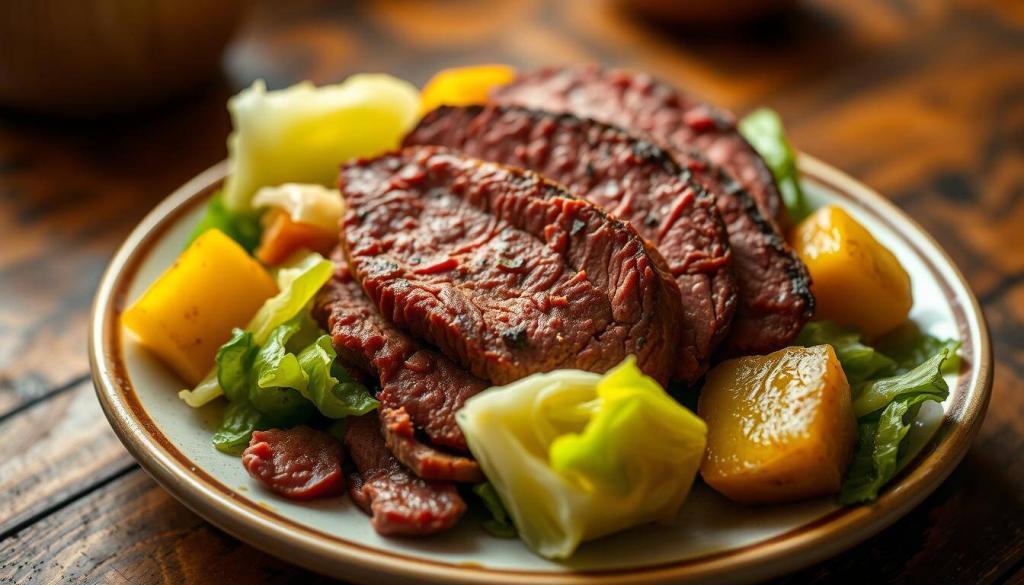
Irish-American Heritage and Cultural Roots
In Ireland, beef was historically reserved for the wealthy, while pork and bacon were staples for working-class families. However, when Irish immigrants arrived in America, they discovered kosher brisket, which was more affordable and readily available. This shift led to the creation of a dish that symbolised their heritage and resilience5.
Cabbage, a humble and versatile vegetable, became a key ingredient due to its affordability and ability to absorb flavours. The one-pot cooking method was practical, saving time and fuel in working-class households. This dish became a point of pride, allowing immigrants to celebrate their roots with a hearty meal6.
From Rural Traditions to a St. Patrick’s Day Classic
What began as a simple, rural meal evolved into a festive tradition. By the 1920s, corned beef and cabbage had become synonymous with St. Patrick’s Day celebrations in America. Despite its humble beginnings, the dish now represents both cultural heritage and the joy of gathering around the table4.
Today, this recipe continues to bring people together, offering a taste of history and tradition. Whether enjoyed on St. Patrick’s Day or as a comforting meal, it remains a testament to the enduring legacy of Irish-American culture.
Key Ingredients and Unique Techniques
Creating a memorable St. Patrick’s Day feast starts with the right ingredients and techniques. The foundation of this dish lies in the quality of the meat and the freshness of the vegetables. A flat-cut brisket, weighing around 3 to 4 pounds, is ideal for achieving the perfect texture7.
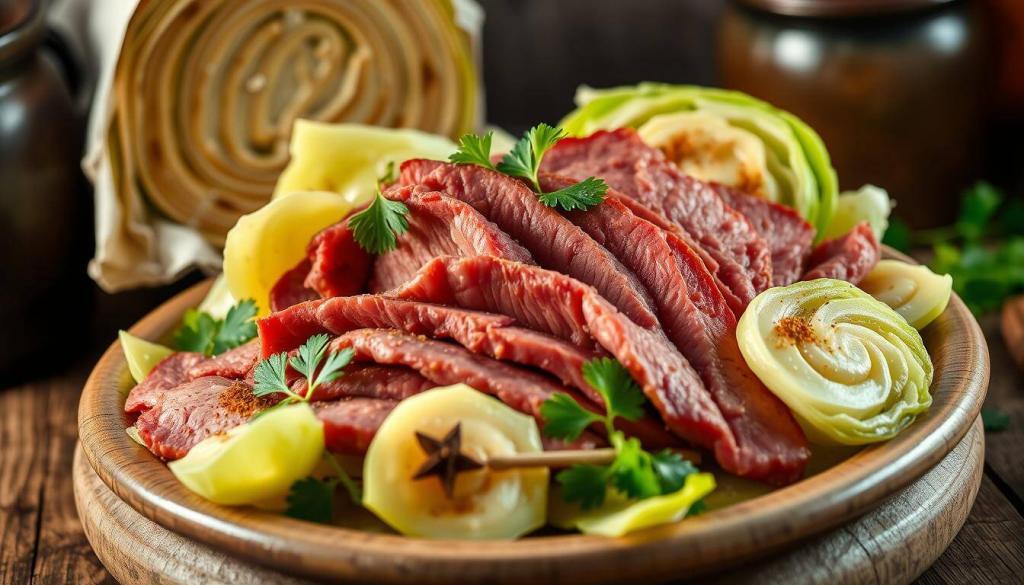
Fresh Produce, Spices and the Perfect Brine
Fresh cabbage, potatoes, and carrots are essential for a hearty meal. Cutting the cabbage into eight wedges ensures even cooking and a beautiful presentation7. For the spices, we recommend creating a custom blend. Discard the pre-packaged spice packet and combine black pepper, mustard seeds, and bay leaves for a richer flavour profile.
The brine is crucial for tenderising the meat. A mix of salt, sugar, and water, infused with spices, ensures the brisket remains juicy and flavourful. Allow the meat to soak in the brine for at least 24 hours before cooking8.
Secret Tips for a Tender, Flavourful Brisket
Slow cooking is the key to a tender brisket. Cook it at 325°F for 2.5 hours, then increase the heat to 350°F when adding the cabbage7. If the meat isn’t fork-tender after the initial cooking time, continue for an additional 30 to 45 minutes7.
For an extra layer of flavour, sear the cabbage wedges for one minute on each side before adding them to the pot. This step enhances the vegetable’s natural sweetness and adds a delightful texture to the dish7.
Authentic American Irish Corned Beef and Cabbage
From modest beginnings to festive tables, this dish has stood the test of time. Its roots lie in practicality, evolving into a symbol of cultural pride and celebration. Today, it remains a beloved tradition, especially during St. Patrick’s Day festivities.
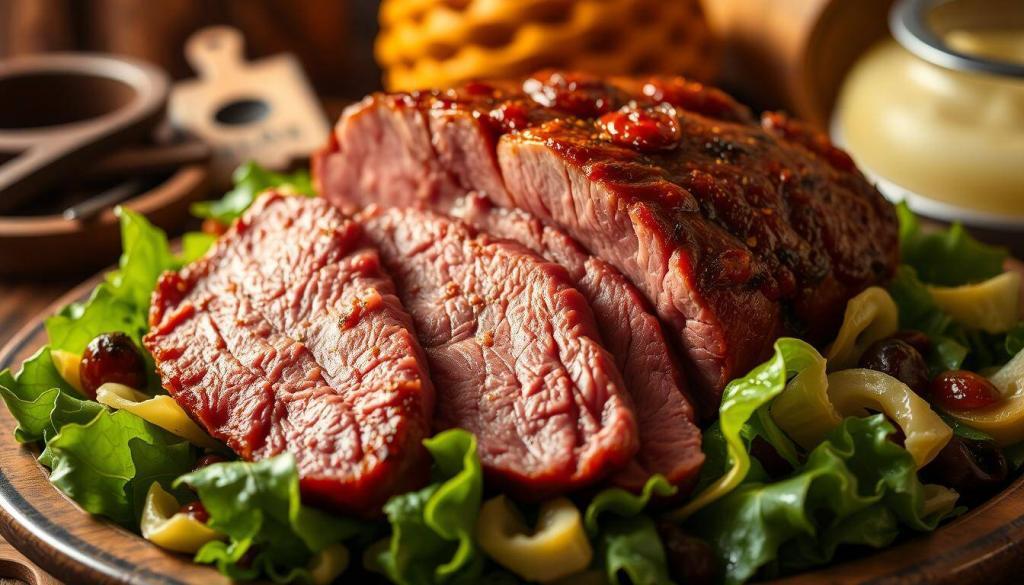
Why This Recipe Became a Timeless Favourite
Originally, this meal was a solution for preserving meat in rural Ireland. Salt-cured brisket, paired with cabbage and potatoes, was both economical and nourishing. When Irish immigrants arrived in America, they adapted the recipe using local ingredients, creating a dish that resonated with their heritage9.
The shift from traditional Irish bacon to brisket was driven by availability and affordability. Kosher brisket, widely accessible in urban areas, became the preferred choice. This adaptation showcased the ingenuity of immigrants and their ability to blend old traditions with new resources9.
Over time, this recipe transformed into a celebratory dish. Its rich, comforting flavours and cultural significance made it a staple for St. Patrick’s Day gatherings. The one-pot cooking method, combining meat and vegetables, also made it a practical choice for families10.
Today, this dish bridges the gap between nostalgia and modern culinary trends. It invites us to embrace history while enjoying a meal that’s both hearty and meaningful. Whether shared at a festive dinner or as a comforting family meal, it continues to bring people together.
Step-by-Step Oven and Stove Cooking Methods
Preparing a hearty meal for St. Patrick’s Day requires careful attention to cooking methods. Whether using the oven or stove, the goal is to achieve tender meat and perfectly cooked vegetables. Let’s explore the best techniques to ensure your dish is a success.
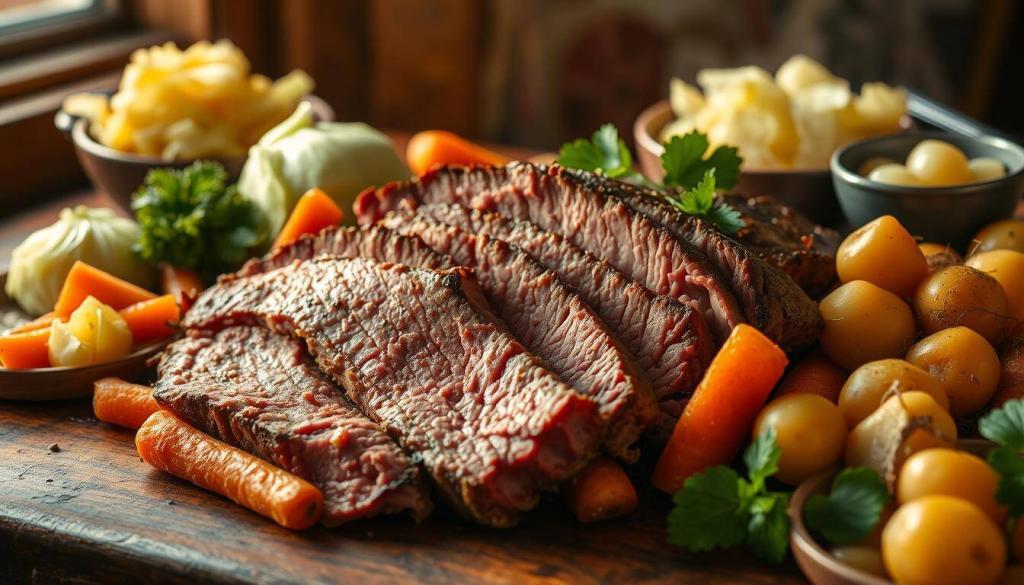
Slow-Cooked Brisket to Perfection
Start by preheating your oven to 325°F. Place the brisket in a heavy baking dish, ensuring it’s snugly fitted. Cover the dish with foil to lock in moisture and cook for 1 hour and 30 minutes before adding vegetables11.
After the initial cooking time, check if the meat is fork-tender. If not, continue cooking for an additional 30 to 45 minutes. This slow-cooking method ensures the brisket remains juicy and flavourful11.
Mastering the Art of Cooking Cabbage and Vegetables
While the brisket cooks, prepare the vegetables. Cut the cabbage into wedges and slice the carrots and potatoes evenly. Add them to the dish after the first 1 hour and 30 minutes of cooking11.
Increase the oven temperature to 350°F for the final cooking stage. This ensures the vegetables retain their colour and texture. For extra flavour, sear the cabbage wedges briefly before adding them to the dish11.
Monitor the heat carefully to avoid overcooking. The result should be a tender brisket and vibrant vegetables, ready to serve and enjoy.
Enhancing Your Feast with Sauces, Sides and Leftovers
Elevate your St. Patrick’s Day feast with a tangy horseradish mustard sauce and inventive ways to repurpose leftovers. These additions not only enhance the flavour but also ensure no part of your meal goes to waste.
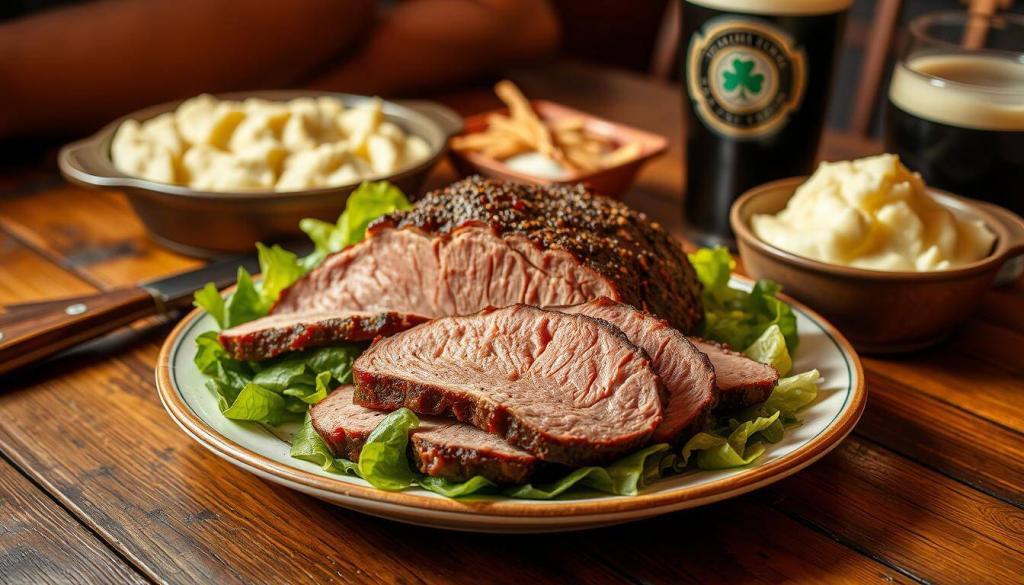
Homemade Horseradish Mustard Sauce
A zesty horseradish mustard sauce is the perfect accompaniment to your dish. Combine 3/4 cup mayonnaise, 3/4 cup sour cream, and 1/4 cup prepared horseradish for a creamy, tangy condiment. This sauce adds a delightful kick to the savoury meat and vegetables12.
Creative Leftover Ideas
Leftovers can be transformed into new meals with minimal effort. Try turning them into a hearty hash by sautéing diced potatoes, onions, and slices of meat in a pan. Alternatively, layer them in a Reuben sandwich with Swiss cheese and sauerkraut for a classic treat13.
For a quick breakfast, consider making a corned beef breakfast crescent ring. This dish combines meat, cheese, and vegetables in a flaky pastry, perfect for a hearty start to the day13.
Plating and Pairing Sides
Presentation matters. Arrange the meat and vegetables on a platter, garnished with fresh parsley for a pop of colour. Pair the dish with boiled new potatoes and lightly dressed cabbage wedges for a complete feast12.
When reheating leftovers, use the oven or a pot on low heat to preserve the texture and flavours. This gentle method ensures the dish remains as delicious as when it was first served13.
Celebrating St. Patrick’s Day with a Heartwarming Feast
Gathering around a shared table, we celebrate the heartwarming flavours of a traditional feast. This dish, with its tender brisket and vibrant vegetables, brings together history and modern culinary excellence. Every minute spent in preparation enriches the experience, making it more than just a meal—it’s a cherished tradition14.
Leftovers can be transformed into new creations, ensuring nothing goes to waste. Try turning them into a hearty hash or a comforting sandwich. These inventive ideas keep the celebration alive, even after the feast is over15.
As we enjoy this meal, we honour its roots and the joy it brings to our tables. Whether shared with family or friends, it’s a reminder of the power of food to connect us all.
Source Links
- St. Patrick’s Day Feast: Irish Inspired Recipes with CHEF iQ – https://chefiq.com/blogs/blog/st-patrick-s-day-feast-irish-inspired-recipes-with-chef-iq?srsltid=AfmBOoqZEDVcVEJIYvwUSPyhbwV0ikpE374i7Usj283jPXqrDmJNWc45
- Corned Beef and Cabbage: A Classic Irish Dish Made Simple • Everyday Cheapskate – https://www.everydaycheapskate.com/a-simple-meal-to-celebrate-st-patricks-day/
- 51 Classic St Patrick’s Day Food Ideas for 2025 – https://www.classpop.com/magazine/st-patricks-day-food
- The history of the New York Irish corned beef and cabbage – https://www.irishcentral.com/culture/food-drink/history-new-york-irish-corned-beef-cabbage
- Corned Beef and Cabbage—America’s Love For St. Patrick’s Day, Explained – https://www.forbes.com/sites/stephaniegravalese/2025/03/16/corned-beef-cabbage-and-americas-love-for-st-patricks-day-explained/
- The Complicated History of Corned Beef – https://www.foodandwine.com/news/complicated-irish-history-corned-beef
- Ree Drummond’s Corned Beef and Cabbage Is a St. Paddy’s Day Tradition – https://www.thepioneerwoman.com/food-cooking/recipes/a11462/corned-beef-and-cabbage/
- The Best Corned Beef You Will Ever Make – https://www.winespectator.com/articles/best-corned-beef-st-patricks-day
- Corn Beef & Cabbage is not an Irish Dish! | Authentic Vacations – https://www.authenticvacations.com/corned-beef-and-cabbage-the-shocking-truth
- This Is the Only Corned Beef and Cabbage Recipe You Need – https://www.simplyrecipes.com/recipes/classic_corned_beef_and_cabbage/
- Best Corned Beef and Cabbage Recipe – Oven-Roasted – https://www.onceuponachef.com/recipes/corned-beef-and-cabbage.html
- Irish Corned Beef and Cabbage – 3 Ways! • The Heritage Cook ® – https://theheritagecook.com/irish-corned-beef-and-cabbage-3-ways/
- 19 Ways to Use Leftover Corned Beef – https://www.allrecipes.com/gallery/leftover-corned-beef-recipes/
- A St. Patrick’s Day Favorite – Zingerman’s Roadhouse – https://www.zingermansroadhouse.com/2019/03/corned-beef-and-cabbage-a-st-patricks-day-favorite/
- How to Make Corned Beef and Cabbage for St. Patrick’s Day – https://www.zulaykitchen.com/en-gb/blogs/recipes/how-to-make-corned-beef-and-cabbage?srsltid=AfmBOoqc1XZhPSYsPIgNTr8AyMD9Z39Q122BkohRT8nCOBI29fezCUle
Footer 1
Call the HERD
Always available for any questions. Call and we will be happy to help.
Follow the HERD
Keep up to date on new products available in store.
Important Links
Join the HERD
Be the first to know about any offers or promotions.
- Herd Butchery 2025

Leave a Reply